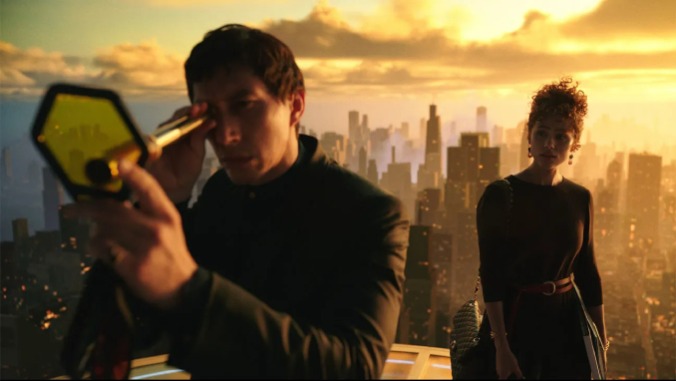Francis Ford Coppola’s Megalopolis Is Bewildering but Brazenly One from the Heart

Francis Ford Coppola has been dreaming about Megalopolis since 1977, when he first conceived the idea for the movie in the midst of filming his heretofore most notorious white whale, Apocalypse Now. In the 40-plus years since, his plans for Megalopolis’ very form have evolved from movie to live theater performance and back to film again. The screenplay has undergone literally hundreds of rewrites.
Watching the film—now finally realized as a 138-minute fever-dream spectacle—this evident, because swaths of Megalopolis feel over-digested by Coppola’s decades of obsessive reworking, a quality that will no doubt prompt millions of liters of digital ink to be spilled on Reddit analyses and valiant attempts at explainer articles. Just as you might watch Coppola’s 1979 magnum opus and then feel the urge to cue up Hearts of Darkness—the illuminating making-of documentary shot during Apocalypse Now‘s filming by Coppola’s late wife Eleanor—Megalopolis similarly leaves you with a hunger to dive below the surface. (An appetite the filmmaker has anticipated, as director Mike Figgis was asked to shoot a behind-the-scenes documentary in tandem with Megalopolis’ making.) The reasons are not the same, however: While the towering scale and how-the-hell-did-they-do-that-ness of the immaculately conceived Apocalypse Now prompts our post-credits curiosity, we seek supplemental material for Coppola’s latest film because it feels much too sprawling and scattershot in its current form to be fully understood without a decoder, untamed as it is by any conventional filmmaking wisdom.
The synopsis floating around before the film’s Cannes premiere framed Megalopolis as charting an ideological battle between idealist urban planner Cesar Catilina (a Caesar cut-sporting Adam Driver) and Giancarlo Esposito’s Franklyn Cicero, the toga-clad, cynical mayor of NYC-proxy New Rome. Though not untrue, this is a charitable description of the movie, because that thread gets tangled up with so many others in Megalopolis‘ labyrinthine plot that it’s doing the film a real generosity to imply that it has a clear throughline. Once again, it’s the movie’s years of gestation that feel to blame here; Coppola hasn’t spent too little time on developing his thesis behind the scenes but so much that he’s seemingly forgotten we haven’t all been on the 47-year-long journey with him, and so he neglects to adequately lay out some of the movie’s underpinning elements.
Most glaring is how little we actually get to see of Cesar’s apparently utopian visions for the future of New Rome, dreamt up after the city is devastated by an event that feels like the stuff of Cold War-era paranoia (just one of several ideologically anachronistic elements that attest to Megalopolis‘ sheer age as an idea). We’re given tantalizing tidbits about Megalon, the physics-defying substance with which Cesar plans to build his futuristic new city, but its actual applications in the world of the film are few and far between, and thus a crucial part of the plot—in fact, its very driver—feels critically underexplored.
And by no means is that oversight a one-off occurrence. Dustin Hoffman (one of several actors in the film facing assault allegations) plays Cicero’s crafty consigliere Nush “The Fixer” Berman, who is dispatched off-screen with starkly little fanfare given how central a role the film suggests he will play. Self-described Hitchcockian intrigue shrouds a woman’s unexplained death, but the mystery dangled in front of us gets muddied in the wrong way by random-seeming eleventh-hour revelations. If you’ve seen the movie’s atmospheric teaser (which makes up its opening scene), you’ll also notice the conspicuous absence of any real elaboration on Cesar’s time-stopping abilities. Even the movie’s much-publicized $120 million budget—famously sourced from Coppola’s own pockets—feels absent in much of the film’s look.
-

-

-

-

-

-

-

-

-

-

-

-

-

-

-

-

-

-

-

-

-

-

-

-

-

-

-

-

-

-

-

-

-

-

-

-

-

-

-

-








































